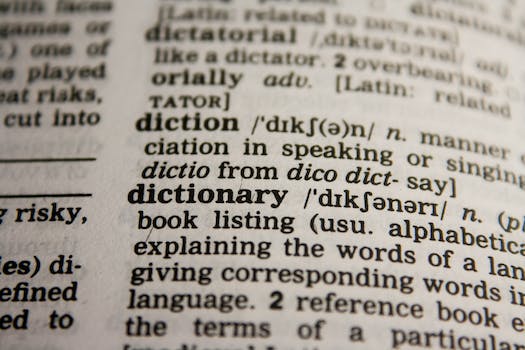Navigating the Language of Poker: A Comprehensive Dictionary of Poker Terms is a comprehensive guide that aims to provide players with a clear understanding of the language and terminology commonly used in the game of poker. This dictionary serves as a valuable resource for both beginners and experienced players, offering definitions and explanations of key terms, phrases, and concepts frequently encountered in various poker variants. Whether you’re playing Texas Hold’em, Omaha, or Stud, this dictionary will help enhance your understanding of the game and improve your overall poker skills.
Understanding the Basics: A Glossary of Common Poker Terms
Poker is a game that has its own language, filled with terms and phrases that may sound foreign to those new to the game. Understanding these terms is crucial for anyone looking to navigate the world of poker. In this section, we will provide a comprehensive dictionary of common poker terms, helping you become fluent in the language of poker.
Let’s start with some basic terms. First up is “ante,” which refers to the small bet that each player must make before the cards are dealt. This ensures that there is always something at stake in every hand. Next, we have “blinds,” which are similar to antes but only paid by certain players. The blinds rotate around the table, forcing players to contribute to the pot even if they don’t want to play a hand.
Moving on, we have “bet,” which is simply placing chips into the pot. A bet can be used as an aggressive move to try and win the pot or as a defensive strategy to protect a strong hand. “Call” is when a player matches the current bet, “raise” is increasing the bet, and “fold” is giving up on the hand and forfeiting any bets made.
Now let’s dive into some terms related to the different stages of a poker hand. The first stage is the “pre-flop,” which occurs before any community cards are revealed. Players assess their hands and decide whether to fold, call, or raise based on their initial cards. Then comes the “flop,” where three community cards are placed face-up on the table. This opens up more possibilities for players to form winning hands.
After the flop, we have the “turn,” which is when a fourth community card is added to the table. This card can significantly change the dynamics of the hand and influence betting strategies. Finally, we have the “river,” which is the fifth and final community card. With all five cards on the table, players make their best five-card hand using any combination of their hole cards (the cards dealt to them) and the community cards.
Now let’s cover some terms related to hand rankings. The highest-ranking hand in poker is a “royal flush,” which consists of the Ace, King, Queen, Jack, and Ten of the same suit. Following that is a “straight flush,” which is any five consecutive cards of the same suit. A “four of a kind” is four cards of the same rank, while a “full house” is three of a kind plus a pair.
Moving down the rankings, we have a “flush,” which is any five cards of the same suit but not in sequential order. A “straight” is five consecutive cards of any suit. Three cards of the same rank make up a “three of a kind,” and two cards of the same rank form a “pair.” If no player has any of these hands, the highest card determines the winner.
We’ve covered just a fraction of the vast vocabulary used in poker, but this glossary should provide you with a solid foundation. As you continue your journey in the world of poker, remember to pay attention to how these terms are used in context. This will help you become fluent in the language of poker and enhance your overall understanding and enjoyment of the game.
Mastering the Lingo: Essential Poker Terminology Every Player Should Know
Poker is a game that has been enjoyed by millions of people around the world for centuries. It is a game of skill, strategy, and luck that requires players to make calculated decisions based on the cards they are dealt. However, mastering the game of poker goes beyond just understanding the rules and strategies. To truly excel in this game, one must also be well-versed in the language of poker.
In order to navigate the complex world of poker, it is essential for every player to have a comprehensive understanding of the terminology used in the game. This article aims to provide a concise dictionary of poker terms that will help players master the lingo and enhance their overall playing experience.
First and foremost, let’s start with the basics. The term “ante” refers to the initial bet that all players must place before the cards are dealt. This ensures that there is always something at stake in each hand. On the other hand, the “pot” is the total amount of money or chips that accumulates during the course of a hand. It is the ultimate prize that all players strive to win.
Moving on to the different types of poker games, “Texas Hold’em” is perhaps the most popular variation played today. In this game, each player is dealt two private cards, known as “hole cards,” which only they can see. These hole cards are then combined with five community cards placed face-up on the table to form the best possible hand.
When it comes to betting, there are several important terms to know. “Check” is when a player chooses not to bet any additional chips but still remains in the hand. “Call” means matching the current bet made by another player. “Raise” involves increasing the current bet, forcing other players to either match the raise or fold their hands. Finally, “fold” means giving up on the current hand and forfeiting any bets already made.
As the game progresses, players may encounter terms such as “bluff” and “tell.” A bluff is when a player makes a bet or raise with a weak hand in order to deceive opponents into thinking they have a strong hand. On the other hand, a tell refers to a physical or verbal cue that reveals information about a player’s hand. Recognizing and interpreting these tells can give players an edge in the game.
In addition to these fundamental terms, there are numerous poker-specific phrases that every player should be familiar with. For example, “bad beat” describes a situation where a player with a strong hand loses to an unlikely combination of cards. “All-in” means betting all of one’s remaining chips on a single hand. “Fish” refers to an inexperienced or unskilled player, while a “shark” is someone who is highly skilled and predatory at the table.
Mastering the lingo of poker is crucial for any serious player looking to improve their skills and understanding of the game. By familiarizing themselves with these essential poker terms, players can communicate effectively with fellow enthusiasts, understand strategy discussions, and enhance their overall playing experience. So, whether you’re a beginner or an experienced player, take the time to study and navigate the language of poker – it will undoubtedly pay off at the tables.
From Ante to Zeebo: Exploring Lesser-Known Poker Terms and Phrases
Poker is a game that has its own language, filled with terms and phrases that may be unfamiliar to newcomers. Understanding these poker terms is crucial for players looking to navigate the world of poker successfully. In this comprehensive dictionary of poker terms, we will explore some lesser-known terms and phrases, from Ante to Zeebo.
Let’s start with the term “Ante.” In poker, an ante refers to a small forced bet that all players must make before the cards are dealt. It ensures there is always money in the pot and adds excitement to the game.
Moving on, we come across the term “Bluff.” Bluffing is a strategy used by players to deceive their opponents into thinking they have a better hand than they actually do. It involves making aggressive bets or raises in order to force other players to fold.
Another important term is “Check.” When a player checks, it means they choose not to bet but still remain in the hand. This can be a strategic move to disguise the strength of their hand or to see what other players will do before deciding whether to bet or fold.
Next up is the term “Donkey.” A donkey is a derogatory term used to describe a poor or inexperienced player who makes foolish mistakes at the table. It’s essential for serious players to identify donkeys as they can often be profitable targets.
Now let’s delve into the phrase “Fish.” Similar to a donkey, a fish is a weak player who consistently loses money. They are easy prey for skilled players, who can exploit their predictable playing style.
Moving along, we encounter the term “Gutshot.” A gutshot refers to an inside straight draw, where only one specific card can complete the straight. For example, if a player holds 2, 3, 5, 6, and needs a 4 to complete their straight, they have a gutshot draw.
Next on our list is the term “Nuts.” The nuts represent the best possible hand at any given moment. It’s important to know when you have the nuts, as it gives you a significant advantage over your opponents.
Now let’s explore the phrase “Tilt.” Tilt refers to a state of emotional frustration or anger that causes a player to make irrational decisions. Going on tilt can be detrimental to a player’s bankroll and overall success in poker.
Finally, we come across the term “Zeebo.” Zeebo is a slang term for a weak or passive player who rarely bets or raises. They are often seen as easy targets by more aggressive players looking to exploit their timid playing style.
Understanding these lesser-known poker terms and phrases will undoubtedly enhance your poker skills and help you communicate effectively with other players. Whether you’re a seasoned pro or just starting out, knowing the language of poker is essential for success at the table. So next time you sit down to play, remember from Ante to Zeebo, this comprehensive dictionary has got you covered.
Building Your Poker Vocabulary: A Comprehensive Dictionary of Poker Terms
Poker is a game that has captivated millions of players around the world. Its allure lies not only in the thrill of winning, but also in the complexity of its language. To truly understand and excel at poker, it is essential to have a solid grasp of the terminology used within the game.
One of the first terms every aspiring poker player should familiarize themselves with is “bluff.” Bluffing is an integral part of poker strategy, where a player makes a bet or raise with a weak hand in order to deceive their opponents into thinking they have a strong hand. This psychological tactic can be highly effective if executed correctly.
Another crucial term is “pot odds.” Pot odds refer to the ratio between the current size of the pot and the cost of a contemplated call. By calculating pot odds, players can determine whether it is mathematically profitable to continue playing a hand. Understanding pot odds is key to making informed decisions and maximizing one’s chances of success.
Knowing the various types of poker hands is also vital. The highest-ranking hand is the royal flush, which consists of the Ace, King, Queen, Jack, and Ten of the same suit. Following closely behind is the straight flush, which is any five consecutive cards of the same suit. Other notable hands include four of a kind, full house, flush, straight, three of a kind, two pair, one pair, and high card.
Furthermore, players must comprehend different betting structures commonly employed in poker. One such structure is “no-limit,” where there is no maximum bet a player can make. This format allows for high-stakes gambling and strategic maneuvers. In contrast, “fixed-limit” poker sets predetermined limits on bets and raises, creating a more structured and controlled environment.
In addition to these fundamental terms, there are numerous specific phrases unique to poker. For instance, “flop” refers to the first three community cards dealt face-up on the table, followed by the “turn” (the fourth card) and the “river” (the fifth card). These community cards are shared by all players and are used in conjunction with their individual hole cards to form the best possible hand.
It is also important to be familiar with terms related to player behavior. “Tilt” refers to a state of emotional frustration or confusion that causes a player to make irrational decisions. Recognizing when one is on tilt is crucial for maintaining composure and making rational choices. Similarly, “tilt control” strategies aim to prevent or minimize the negative impact of tilt on a player’s performance.
Lastly, being aware of common poker abbreviations can greatly enhance communication at the table. For instance, “BB” stands for big blind, “UTG” for under the gun (the first player to act pre-flop), and “MTT” for multi-table tournament. Understanding these abbreviations will facilitate smoother gameplay and ensure that players are on the same page.
In conclusion, mastering the language of poker is an essential step towards becoming a skilled player. By familiarizing oneself with bluffing techniques, pot odds, hand rankings, betting structures, community cards, player behavior, and abbreviations, individuals can navigate the intricate world of poker more confidently. Whether you are a novice looking to improve your skills or an experienced player seeking to refine your knowledge, building a comprehensive vocabulary of poker terms is a vital aspect of your journey towards success.In conclusion, “Navigating the Language of Poker: A Comprehensive Dictionary of Poker Terms” is a valuable resource for both beginner and experienced poker players. It provides a comprehensive collection of poker terms, helping players understand and communicate effectively within the poker community. Whether it’s learning new terminology or clarifying existing ones, this dictionary serves as a handy reference guide for anyone looking to enhance their understanding of the language used in poker.





